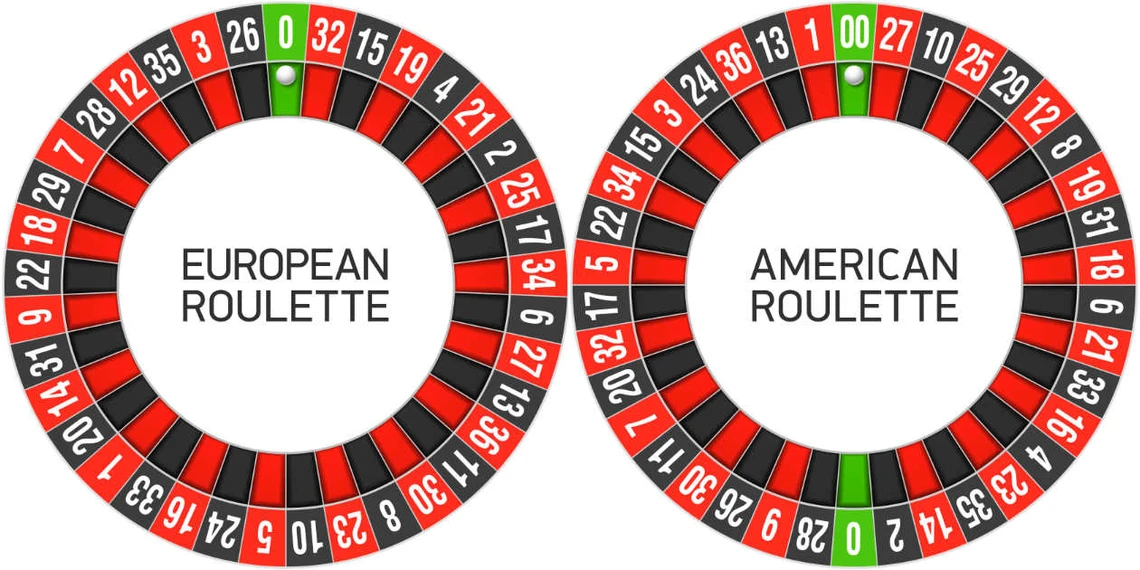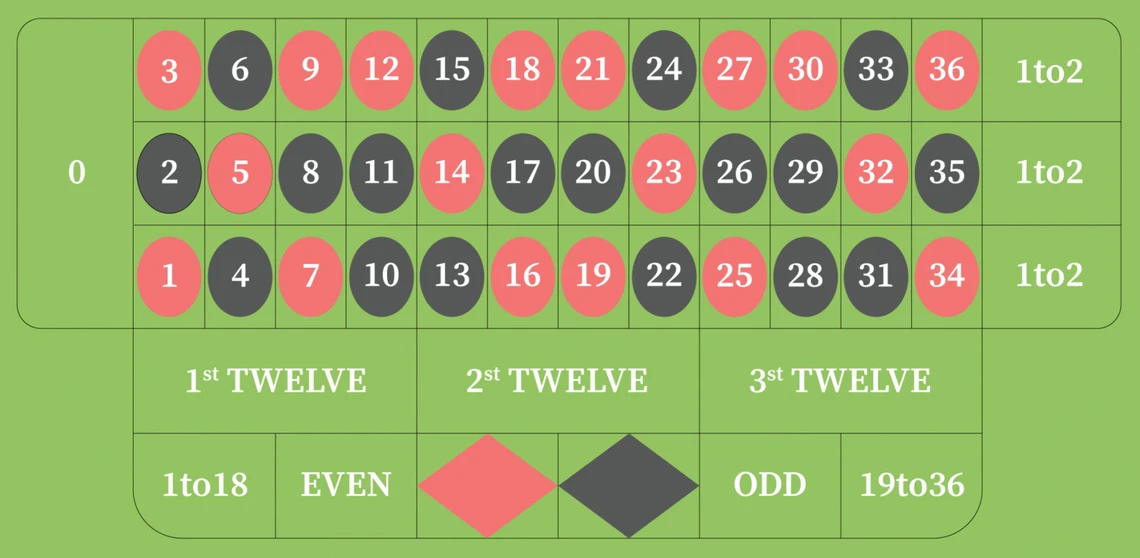
What Are The Numbers In The Roulette?
Roulette has captivated players for centuries, with its spinning wheel and the thrill of watching the ball land on a single number. The excitement of the game lies in its numbers, each holding the potential for fortune.
In this article, you'll learn the basics of roulette numbers, why some numbers are more popular than others, and how to use this knowledge to improve your betting strategy.
The Basics of Roulette Numbers
How many numbers are there in roulette?
The number of pockets on a roulette wheel varies depending on whether you're playing the European or American version of the game.
- European Roulette: The wheel has 37 pockets, numbered from 0 to 36. The single 0 pocket is green, while the numbers 1 to 36 are split evenly between red and black.
- American Roulette: The wheel has 38 pockets, including an additional 00 pocket. Like the 0, the 00 pocket is green. The presence of the extra 00 increases the house edge, making American roulette slightly less favorable for players compared to its European counterpart.
The inclusion of the 00 in American roulette affects the odds of the game. For example, in European roulette, the house edge is about 2.7%, while in American roulette, it's higher at around 5.26%. This difference makes the European version more popular among serious players.
|
Roulette Version
|
Number of Pockets
|
Number Range
|
Green Pockets
|
Red Pockets
|
Black Pockets
|
House Edge
|
|---|---|---|---|---|---|---|
|
European Roulette |
37
|
0 to 36
|
1 (0)
|
18
|
18
|
Lower (2.7%)
|
|
American Roulette |
38
|
0, 00 to 36
|
2 (0, 00)
|
18
|
18
|
Higher (5.26% due to 00)
|
This table highlights the differences between European and American roulette, focusing on the number of pockets, distribution of colors, and the house edge.
Order and Distribution of Numbers on a Roulette Wheel
At first glance, the sequence of numbers on a roulette wheel might appear random, but it's carefully designed to balance different types of bets:

- European Roulette: The numbers are arranged in a specific sequence to ensure that no two consecutive numbers are adjacent on the wheel. Additionally, high and low numbers, odd and even numbers, and red and black pockets are evenly distributed around the wheel. This layout ensures a balanced distribution of outcomes, maintaining the unpredictability of the game.
The list and arrangement of numbers in European Roulette wheel with single zero: 0, 32, 15, 19, 4, 21, 2, 25, 17, 34, 6, 27, 13, 36, 11, 30, 8, 23, 10, 5, 24, 16, 33, 1, 20, 14, 31, 9, 22, 18, 29, 7, 28, 12, 35, 3, 26
- American Roulette: The arrangement of numbers follows a similar principle, with the 0 and 00 placed opposite each other on the wheel. The rest of the numbers are also balanced to ensure a mix of high, low, odd, even, red, and black numbers.
The list and arrangement of numbers in American Roulette wheel with double-zero 0, 28, 9, 26, 30, 11, 7, 20, 32, 17, 5, 22, 34, 15, 3, 24, 36, 13, 1, 00, 27, 10, 25, 29, 12, 8, 19, 31, 18, 6, 21, 33, 16, 4, 23, 35, 14, 2
Influence on Betting : This seemingly random arrangement has a significant impact on gameplay and strategy. For example, it prevents players from easily predicting outcomes based on previous spins, making each round independent of the last. This randomness is a core part of what makes roulette both challenging and exciting, as it ensures that no specific betting strategy can consistently predict the outcome of a spin.
Arrangement of numbers on a roulette table
The numbers on a roulette table are arranged in a grid layout, designed to provide various betting options for players. Here's how the numbers are typically arranged:

Number Grid
The main section of the roulette table consists of 12 rows and 3 columns, containing the numbers 1 through 36. The numbers are ordered sequentially, starting with 1 at the top left and ending with 36 at the bottom right.
- Columns: The columns run vertically, and each one contains 12 numbers. For example, the first column includes numbers like 1, 4, 7, and so on. The second column starts with 2, 5, 8, and so forth, while the third column begins with 3, 6, 9, etc.
- Rows: The rows run horizontally across the table, with each row consisting of three consecutive numbers (e.g., the first row is 1, 2, 3; the second row is 4, 5, 6).
Special Zones
- Zero (0) and Double Zero (00): In European roulette, the single 0 is placed at the top of the grid, while in American roulette, both 0 and 00 are placed side by side at the top. These numbers are separate from the main grid and are usually in a green zone.
Betting Areas
The numbers are grouped in various ways to offer different betting options. For instance:
- Red/Black: Players can place bets on whether the winning number will be red or black. These options are usually located to the sides of the main number grid.
- Odd/Even: Players can bet on whether the winning number will be odd or even. These options are also found to the side of the number grid.
- High/Low: Players can bet on whether the number will be in the lower half (1-18) or the upper half (19-36) of the number range.
- Dozens: The numbers are divided into three groups of 12 (1-12, 13-24, 25-36). Players can bet on one of these groups, with the betting area for dozens located below the number grid.
- Columns: There are three additional betting options at the bottom of each column, allowing players to bet on all 12 numbers in a specific column.
This layout provides a variety of betting options, from safer, even-money bets to riskier, high-payout bets.
Influence on Betting : This This arrangement allows for a wide range of betting options, from single numbers (straight bets) to broader categories like odd/even or red/black (outside bets). The layout encourages strategic betting, as players can choose to spread their bets across various options or concentrate them in specific areas, depending on their preferences or strategies.
Winning Numbers and Probability Myths
The Reality of Roulette: A Game of Chance
- Equal Probability: Each number on the roulette wheel has an equal probability of hitting in a single spin. In European roulette, the probability is 1 in 37 (2.7%), and in American roulette, it's 1 in 38 (2.63%) due to the additional 00 pocket.
- Myth of "Lucky" or "Winning" Numbers: There is no scientific basis for "lucky" or "winning" numbers in roulette. Each spin is independent of the previous ones, and the outcome is purely random, meaning that past results do not influence future spins.
The Hot Numbers
"Hot" numbers refer to those that have appeared more frequently in recent spins during a game session.
- Strategic Advantage: While some players believe that betting on hot numbers can increase their chances of winning, this is a misconception. The likelihood of any number hitting remains the same with each spin, regardless of how often it has appeared recently.
Popular Numbers
Some numbers have gained popularity due to cultural significance, superstition, or historical anecdotes. For example, 17 is often favored by players, possibly due to its central position on the table and its appearance in various famous roulette stories.
- List of Popular Numbers: Numbers like 7, 17, 23, and 8 are commonly chosen by players and are considered "lucky" by many. However, these numbers do not have any statistical advantage over others.
- Strategic Advantage: Despite their popularity, frequently chosen numbers do not offer any strategic advantage. The randomness of roulette means that every number has the same chance of appearing in any given spin.
Lucky Numbers
Many players have personal favorite numbers that they consider "lucky." These might be based on birthdates, anniversaries, or other personal significance.
- Strategic Advantage: While betting on personal "lucky" numbers can make the game more enjoyable for some, there is no strategic advantage in doing so. Like hot or popular numbers, lucky numbers are subject to the same rules of probability, with no greater chance of winning than any other number.
Roulette Numbers Sequence
Some players look for patterns or sequences in the numbers to guide their betting decisions. The idea is that by observing past results, they can predict future outcomes or at least identify trends that might give them an edge.
Common Sequences Players Look For:
- Consecutive Numbers: Some players believe that numbers appearing in close succession on the wheel are more likely to hit. For example, if the ball lands on 14, they might bet on 13 or 15 in the next round.
- Neighbors: A popular strategy involves betting on "neighbors," which refers to the numbers adjacent to the winning number on the wheel. For instance, if 22 wins, a player might place bets on 18, 29, 7, and 28, which are its neighbors on the wheel.
- Repeaters: Another sequence strategy is betting on numbers that have recently won, based on the belief that certain numbers might "repeat" within a short period.
- Strategic Advantage: As with the other myths studied, these sequences are based only on intuition or superstition and of course offer no guarantee of winning.
Advices for Choosing Your Numbers
- Practical Tips for Selecting Numbers: Choose numbers based on superstition, statistical patterns, or personal preference, but remember that every spin is random with no guaranteed winning formula.
- Experimentation and Fun: Try different strategies in a controlled way, focusing on enjoying the game rather than chasing a win, as roulette is ultimately a game of chance.
Now that you know about all the numbers, you can test your luck on the best casinos for roulette players.

Author
Content Writer